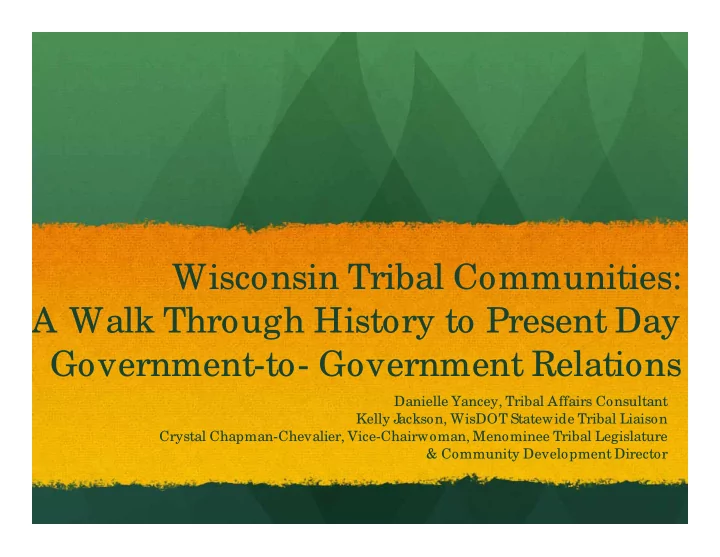

Wisconsin Tribal Communities: A Walk Through History to Present Day Government-to- Government Relations Danielle Yancey, Tribal Affairs Consultant Kelly J ackson, WisDOT Statewide Tribal Liaison Crystal Chapman-Chevalier, Vice-Chairwoman, Menominee Tribal Legislature & Community Development Director
Overview Brief historical overview and introduction to Wisconsin’s Tribal communities State and Tribal perspectives Q&A
Wisconsin ACT31 Wisconsin Education Act 31 refers to the statutory requirement to teach history, culture, and tribal sovereignty of the twelve American Indian nations and tribes in the state.
Placed Base Learning Essential Understandings Nations Tribal Sovereignty People History Culture
Opening Questions
Indigenous People Original inhabitants of North America, presence time immemorial Estimates vary from 5 to 30 million Over 800 Tribal Nations Each Nation is Distinct and Different with their own language, culture, traditions, laws and systems of governance Inherent sovereignty
Why History is Important Tribes’ present day status is the result of 500+ years of history “Indian Problem” and Colonization Battles over land Assimilation
Battle over Tribal Lands European Discovery Era Doctrine of Discovery - Spanish international law used to give exclusive rights of lands Removal Era Forced removal Trail of Tears (“death marches”) Treaty-making Era Nearly 400 treaties signed and broken
Allotment & Assimilation 1887-1928 1887 General Allotment Act (Dawes Act) Broke up commonly held lands Non-Indians can now purchase lands People had to prove blood quantum to receive allotment Surplus lands sold to Whites
Interactive Map Cessation of Tribal Lands https:/ / www.youtube.com/ watch?v=ZZCvUroBpaE
Assimilation 1887-1928 Boarding School era Carlisle Boarding School – Pennsylvania Henry Pratt – “Kill the Indian, Save the Man” Indian Civilization Act Fund, a collaboration with churches
Boarding School Era Children were taken as young as 4 years old Given Christian names, hair cut, given European style clothing 500 boarding schools in 18 states – Wisconsin Boarding Schools: Keshena (Menominee), Oneida, Lac du Flambeau, and Tomah 100,000 children taken from 1879 and the 1960’s
Boarding School Era Children were punished and beaten for speaking their language and cultural practices and traditions Used for labor, molested and raped Many children died – loneliness, sickness, suicide 1879-1918 at Carlisle 293 deaths reported; 1135 were sent home because they were sick, like to die at home or on their way
Reorganization 1924-1945 1924 Indian Citizenship Act - Congress conferred citizen status 1935 Indian Reorganization Act (IRA) Protected Tribes’ remaining land base – ended allotment Self-governance Adopt constitutions Tribal government structures – Chairman, President, Governor, Chief
Termination & Relocation 1945-1961 Termination Ended federal recognition of Tribes Menominee terminated in 1953 Relocation Designed to relocate to urban areas through work relocation programs and housing
Self-Determination 1968-1988 Self-Determination and Education Assistance Act of 1975 Ended termination policy Enter into contracts and deliver grants directly to Tribal governments
Legislation that Supports Self-Determination Restoration Act Buy Indian Act Native American Graves and Repatriation Act National Historic Preservation Act American Indian Religious Freedoms Act Indian Child Welfare Act Indian Gaming Regulatory Act Federal and State Executive Orders
Gaming Era Indian Gaming Regulatory Act of 1988 Compact agreements Economic development to provide services to Tribal members Largest employers in counties Myth Buster – not all Tribal members receive casino payouts
Impacts Total U.S. land mass is 2.3 billion acres By 1934 Tribes held only 50 million acres, barely 2 percent of their original territory Over two centuries Native population dropped by 95 percent
Tribes Today Over 560 federally recognized Tribes throughout the United States today Each has their own distinct history, culture, tradition, and government structure 4.9 million American Indians/ Alaskan Natives in the United States (2008); 1.6 percent of population 22 percent live on reservations or trust lands 60 percent live in metropolitan areas
Wisconsin Tribes Brothertown Indian Nation (non-federally recognized Tribe)
Population in WI Over 69,000 people identify as AI/AN (alone or in combination). Not all are members of Wisconsin tribes or bands. ~1/3 of the AI/AN population is on-reservation, ~1/3 in nearby towns, and ~1/3 in urban areas. Milwaukee is the largest Native community in the state (9,116). Green Bay ranks 5th nationwide in % of AI/AN population among cities of 100,000+
Tribal Enrollment Nation Enrollment Bad River Band of Lake Superior Chippewa 6,945 Lac Courte Oreilles Band of Lake Superior Chippewa Indians 7,275 Lac du Flambeau Band of Lake Superior Chippewa Indians 3,415 Red Cliff Band of Lake Superior Chippewa Indians 5,312 Sokaogon Chippewa Community 1,377 St. Croix Chippewa Community 1,054 Forest County Potawatomi Community 1,400 Stockbridge-Munsee Band of Mohican Indians 1,565 Oneida Nation of Wisconsin 16,567 Ho-Chunk Nation 6,563 Menominee Nation 8,720
Tribal Governments Self-governance: Tribal council or legislature Laws/ ordinances; jurisdiction over Tribal lands and members Tribal police and courts systems Economic development (gaming and tourism) Education
State-Tribal Relations State Government Perspective Kelly J ackson Statewide Tribal Liaison Wisconsin Department of Transportation Tribal Affairs Program
Tribal Leadership Tribal Leadership Perspectives Crystal Chapman-Chevalier Vice-Chairwoman, Menominee Tribal Legislature and Community Development Director
Resources Individual Tribal Websites Great Lakes Inter-Tribal Council http:/ / www.glitc.org Great Lakes Fish and Wildlife Commission http:/ / www.glifwc.org National Congress of American Indians http:/ / www.ncai.org
Resources UW-Madison School of Education – Act 31 http:/ / wisconsinact31.org The Ways http:/ / theways.org State of Wisconsin Department of Administration http:/ / witribes.wi.gov Local and National Tribal publications and newspapers
Resources State of Wisconsin Department of Transportation http:/ / wisconsindot.gov/ Pages/ doing-bus/ civil- rights/ tribalaffairs WisDOT Inter-Tribal Task Force http:/ / wisdottribaltaskforce.org WisDOT Tribal Historic Preservation Project http:/ / wisdotpreservation.org WisDOT Tribal Labor Advisory Committee http:/ / wisdottlac.org
Wrap-Up Each Tribe is distinct and unique with their own language, culture, history and current government structure and priorities Early and meaningful consultation is essential 3 R’s – Respect, Relationship, and Reciprocity Pursue your knowledge and understanding of Wisconsin Tribes Prepare and do your homework when engaging with Tribal communities
Future Trainings & Opportunities Annual State of the Tribes Address (early 2017) WisDOT Tribal Historic Preservation Project Listening Session – J anuary 31-February 2, 2017 Stevens Point, WI WisDOT Cultural Sensitivity Training
Questions Thank you! Waewaenen! Miigwitch!
Recommend
More recommend